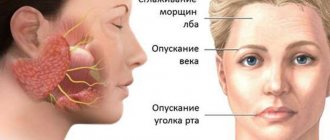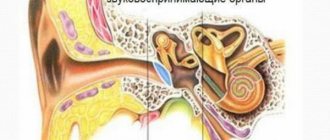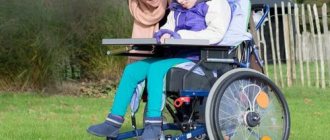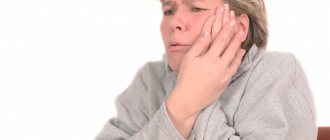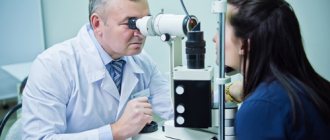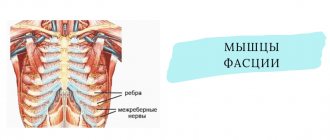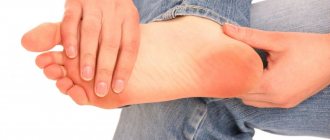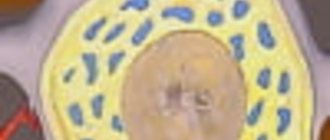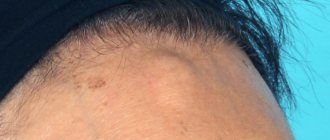Causes of pain in the shoulder joints
There are many reasons for the appearance of painful sensations. Pain in one or both shoulders can be a consequence of inflammation of the tendons, microtrauma of the articular cartilage, inflammatory-degenerative pathologies of the joints and cervicothoracic spine. The discomfort can be either minor or so intense that you cannot move your arm.
Among the causes that cause sharp or aching pain in the shoulder are:
- one-sided intense load for a long time;
- scoliosis, lordosis and other deviations in the normal position of the spine;
- physical inactivity.
In addition, pain can occur due to infections, inflammatory processes, hereditary predisposition, diseases of internal organs, and tumors.
In cases where the right shoulder hurts, the following pathologies may be present:
- Tendonitis is inflammation of tendons and soft tissues due to significant physical activity.
- Myositis - when the muscles of the shoulder joint are involved in the inflammatory process.
- Arthrosis is the destruction of articular cartilage.
- Arthritis is an inflammatory process in a joint due to infection, allergic reaction or autoimmune diseases.
- Osteochondrosis of the cervical spine.
- Bursitis is an inflammation of the joint capsule.
- Capsulitis is a pathological change affecting the joint capsule and synovium.
- Brachial nerve neuritis.
- Tuberculous lesion of the joint on the right.
- Humeroscapular periarthritis.
- Metastasis from a nearby tumor.
- Chondrosarcoma.
- Right-sided pneumonia.
Pain in the left shoulder joint is much less common, especially if the person is right-handed. Still, the load on the left hand is significantly less compared to the right. When your left shoulder hurts, the reasons may be the following:
- sprain;
- biceps tendinitis;
- intervertebral hernia in the cervical spine;
- calcification in the tendon;
- angina pectoris or myocardial infarction.
There are cases when the shoulder hurts when raising your arm. Here we can talk about pathologies such as:
- joint injuries;
- rheumatic lesion;
- rotator cuff tendinitis;
- tenosynovitis;
- tendobursitis and bursitis;
- myositis;
- hernia of the cervical spine.
The appearance of pain in the shoulder when trying to move the arm back indicates the presence of bursitis, radiculitis, tendinitis, spinal overload, arthrosis-arthritic joint damage, myocardial infarction.
Symptoms of the disease
Shoulder pain manifests itself in different ways depending on the cause. Acute is typical in case of injury. When a bruise, dislocation or sprain occurs, the patient experiences discomfort that increases when moving the upper limb. When a fracture occurs, it becomes impossible to move the arm.
Unbearable pain radiating to the neck and upper back is observed with capsulitis. In addition to pain, there is an inability to move the arm back or raise it. Severe pain also occurs with brachial neuritis and arthritis. The first is characterized by the absence of signs of inflammation in the joint; in the second case, swelling of the soft tissues and limited range of motion are noticeable.
Aching pain in the shoulder may be a sign of osteochondrosis of the cervicothoracic spine. Often the symptom is accompanied by numbness of the hand, burning and tingling sensation in the fingers. Aching pain is also observed with deforming arthrosis, but in this case, along with discomfort, a person notes stiffness of movement and swelling in the shoulder joint in the morning, crunching and clicking when bending/extending the arm. With the gradual destruction of cartilage, lifting heavy objects or active movement provokes increased pain.
Constant pain for several weeks is characteristic of bursitis, when the inflammatory process develops in the periarticular bursa. The disease is accompanied by the formation of a compaction, upon pressing on which a fluid transfusion is felt.
Treatment
The treatment of periarthrosis should be approached carefully and the recommendations of the attending physician should be followed with all scrupulousness. Only in this case can you count on the success of therapy and complete restoration of the function of the shoulder joint, especially when contacting an orthopedist in the early stages.
First of all, it is necessary to limit the mobility of the diseased limb and eliminate the influence of factors that provoke the development of glenohumeral periarthritis. In this case, complete immobilization of the hand is not required, as this is fraught with the occurrence or aggravation of dysfunction of the joint. It is important to understand that only complete abstinence from those types of movements that provoke pain is indicated. Treatment of glenohumeral periarthrosis requires an integrated approach. A gentle regime is necessary both for the spinal column itself, and in particular for the cervical spine.
Also, start complex treatment immediately. As a rule, in most cases, they begin with conservative therapy. It includes:
- drug therapy;
- physiotherapy;
- Exercise therapy.
But if the patient has already developed adhesive capsulitis, he is indicated for surgical intervention. It involves eliminating adhesions and separating fused areas of tissue. As a result, the operation allows you to increase the mobility of the affected joint and significantly improves the prognosis of the course of glenohumeral periarthritis in general. It is performed arthroscopically, i.e. using special endoscopic equipment. It is introduced through pinpoint incisions of soft tissue directly into the area of the shoulder joint, which ensures a good cosmetic effect. Surgery is also required for patients with complete rupture of the rotator cuff tendons. In some cases, it is necessary to fix the upper limb with an abductor splint and immobilize the cervical spine with a head holder (Schanz collar).
Drug therapy
If the patient consults a doctor during the acute period of development of periarthrosis, the main task is to reduce the severity of pain, eliminate swelling and inflammation of the soft tissues, as well as relax the spasmed muscles. Mainly, they are solved by blocking trigger points with solutions of local anesthetics and corticosteroids. The injection sites for the drugs are determined based on which structures have undergone the development of the inflammatory process. Therefore, they can be inserted both into the subacromial bursa and inside the joint itself.
For a simple form of periarthrosis, as a rule, 1 injection is sufficient, for an acute form – 2-3.
If the patient consults a doctor when the pain has been present for a long period of time, then systemic drug therapy is indicated. It involves prescribing a complex of medications, in particular:
- NSAIDs - used to relieve pain and reduce the severity of the inflammatory process (both locally and internally);
- muscle relaxants – used to relieve muscle spasms, especially if muscular-tonic syndrome is observed;
- chondroprotectors - prescribed to stop further progression of degenerative-dystrophic changes that have arisen in the shoulder joint;
- hyaluronic acid preparations - used to improve the course of natural regeneration processes in the shoulder joint (introduced periarticularly, i.e. into the tissue surrounding the joint);
- B vitamins - used to improve the quality of transmission of nerve impulses.
Physiotherapy
Physiotherapeutic procedures are prescribed to increase the effectiveness of drug therapy. As a rule, for glenohumeral periarthritis, courses of sessions are indicated:
- phonophoresis, since ultrasonic waves help to reduce the density of connective tissue and increase the degree of its permeability to drugs;
- shock wave therapy, which involves the use of short pulses of high-energy shock waves, which helps improve blood circulation in the area of impact and crush calcifications;
- electrophoresis with the introduction of corticosteroids to reduce the severity of the inflammatory process;
- mud therapy and sulfide baths to consolidate the results of the treatment.
Physiotherapeutic procedures are prescribed in courses. Moreover, combining several types of physical influence in one day is not recommended, since they can either enhance or reduce each other’s effects. Therefore, the attending physician draws up an exact physiotherapy regimen, taking into account all the features of the procedures. The optimal interval is to perform them every other day.
Diagnosis of pathology
Naturally, when there is discomfort, the question inevitably arises: what to do if your shoulder hurts? Don't wait for the symptoms to go away on their own. It is imperative to consult a doctor, whose specialization will depend on the cause of the disease and the general condition of the patient.
If the pain appears after a fall or bruise, then contact a traumatologist. Osteochondrosis and neuritis are treated by a neurologist, a surgeon and a rheumatologist eliminate the consequences of arthrosis, arthritis and tendonitis.
When painful sensations are accompanied by a general deterioration in well-being, it is recommended to consult a therapist, oncologist, cardiologist or gastroenterologist. Indeed, sometimes pain is reflected when there is a discrepancy between the localization of discomfort and the location of damaged organs or tissues. It is very important to diagnose in time, because shoulder pain can appear due to myocardial infarction, pneumonia, pleurisy, pancreatitis, cholecystitis, and neoplasms in the chest.
For diagnostic purposes, the doctor may prescribe the following types of examinations:
- X-ray of the shoulder or entire upper limb;
- Ultrasound of the shoulder joint;
- MRI of the joint and/or spine;
- ECG.
In addition, you may need to take a general blood test, as well as biochemistry and sexually transmitted infections. The patient is also prescribed fluorography and fibrogastroduodenoscopy.
Prevention and prognosis
If, in addition to the main concern, you notice disturbances in the cardiovascular, urinary and endocrine systems, atrophy of the musculoskeletal system and proliferation of connective tissue are possible.
Prevention of the disease includes early diagnosis of infectious diseases and their subsequent treatment, avoidance of injuries and hypothermia of the upper limb, as well as proper nutrition and avoidance of cigarettes and alcohol.
The modality of treatment depends on the causative factor . Do not forget that if detected in time, the disease can be easily treated.
Treatment for pain in the shoulder joint
When complaining of pain in the shoulder, the specialist prescribes comprehensive treatment. Therapy includes:
- Local and general anesthesia. Can be achieved using medications or physiotherapeutic methods, acupuncture, etc.
- Eliminating the root cause of pain. Manual therapy, osteopathy, PRP therapy and Kinesitherapy help with this.
- Symptomatic therapy. They use products to relieve swelling of soft tissues, hyperemia of the skin, and reduce temperature.
- Rehabilitation treatment. This includes kinesitherapy.
During the rehabilitation period, physical therapy and physiotherapeutic treatment are widely used to restore joint mobility. In advanced cases and in the absence of effect from conservative therapy, surgical treatment is possible.
The article was reviewed by traumatologist-orthopedist V.Yu. Bogdanov.
Treatment of lesions (neuropathy) of the suprascapular nerve
Treatment of any suprascapular nerve injury should begin with four to six weeks of conservative measures that include anti-inflammatory medications, limited overhead activity, and physical therapy that includes exercises to strengthen the scapular stabilizers and rotator cuff.
Even ganglion cysts of the spinous glenoid sulcus can dissolve spontaneously, but such patients should be closely monitored to monitor the dynamics of symptoms.
Surgical treatment is indicated when conservative measures are ineffective or nerve compression is confirmed by electromyography. Decompression of the nerve helps to significantly reduce the intensity of pain, but recovery of the atrophied muscle is difficult to predict.
Surgical treatment of suprascapular nerve damage:
- Open release of the transverse scapular ligament and spinoglenoid ligament
- Arthroscopic release of the transverse scapular ligament
- Percutaneous release of the transverse scapular ligament
- Elimination of compression of the distal parts of the suprascapular nerve, which developed as a result of the formation of a ganglion cyst
- Endoscopic release of the spinoglenoid ligament
Open ligament release
The open release technique of the transverse scapular ligament and spinoglenoid ligament is rarely used. The intervention can be performed through a single skin incision using superior or posterior approaches. To perform it, the operated limb is draped loosely with surgical linen, and the patient is positioned in a position midway between the position on the side and on the stomach.
Cost of treating shoulder pain in our Center
| Services list | Price |
| Initial consultation with a kinesiotherapist | 1600 |
| Interim consultation with a kinesiotherapist | for free |
| Session with a kinesiotherapist (1 patient) | 3900 |
| Individual lessons with a personal trainer | 2700 |
| Subscription for 1 month of training in the gym on simulators | 10 000 |
| Subscription for 6 months of gym training | 45 000 |
| Physiotherapist consultations | 1600 |
| Physiotherapist consultations during the cycle | for free |
| UVT 1 procedure | 2000 |
| HIVAMAT up to 15 min./1 body unit | 2200 |
| HIVAMAT up to 15 min./2 body units | 3200 |
| Appointment with an orthopedist-traumatologist | 1600 |
| Intra-Articular PRP Injection | 6500 |
| Massage of one upper limb (15 min.) | 2200 |
| Massage of two upper limbs (30 min.) | 3000 |
| Kinesio taping | 1100 |
| Complex taping (joints) 1 zone | 1600 |
| Complex taping (joints) 2 zones | 2200 |
Contact us
Call now
8 (495) 803-27-45
Make an appointment through our service
Make an appointment
Treatment process at the Innovation Center
Our Innovative Clinic has created excellent conditions for the diagnosis and treatment of pain in the shoulder joints of various types and origins. After finding out the causes of the pathology, the doctor will select tactics and methods of treatment. We practice using the following techniques:
- Acupuncture.
- Manual therapy.
- Kinesitherapy.
- Osteopathy.
- Massotherapy.
- Physiotherapy.
We achieve excellent results using shock wave therapy and Hiwamat therapy. The course of treatment is carried out under the supervision of a doctor, whose efforts are aimed not only at relieving unpleasant symptoms, but also at eliminating the cause of discomfort. The professionalism of our specialists and an individual approach will help you completely get rid of the problem, and if this is not possible, then avoid complications and achieve stable remission. This is confirmed by a large number of reviews about the work of our center and doctors both on our website in the Reviews section and on other sites on the Internet.
4. Results of neurolysis
The best results of neurolysis are achieved with incomplete separation of the roots of the brachial plexus trunks. There is a restoration of the functionality of the peripheral nerves and the mobility and sensitivity of the limb returns. The result is not always a complete recovery, but even partial mobility of the arm for such patients is a significant relief that improves the quality of life. This “useful” recovery after neurolysis is noted by up to 80% of patients.
It is worth noting that rehabilitation
. As a rule, muscles have time to atrophy to one degree or another. Adequate postoperative measures are designed to restore not only sensitivity, but also muscle strength, accuracy of movement and plasticity of the limb.
